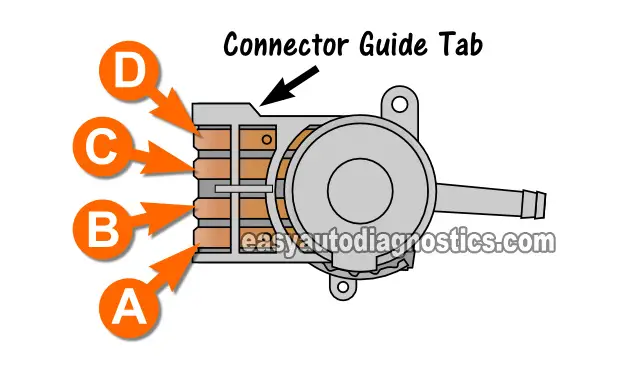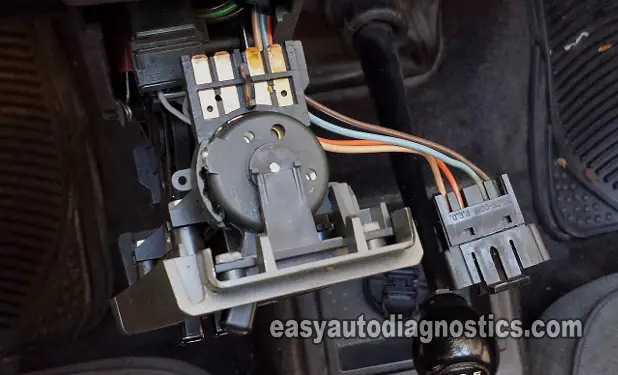
The blower motor control switch, on your Chevrolet S10 pickup (GMC S15 pickup, GMC Sonoma) can be easily tested to find out if it's bad (or not). In this tutorial, I'll show you two different ways of doing this.
With your test results, you'll quickly and easily find out if the blower speed switch is good or bad.
NOTE: This tutorial applies to vehicles equipped with AC.
Contents of this tutorial:
- Symptoms Of A Bad Blower Speed Control Switch.
- Basics Of Troubleshooting The Blower Speed Control Switch.
- Blower Motor Speed Switch Circuit Descriptions.
- Where To Buy The Blower Switch And Save.
- TEST 1: Checking Continuity Of The Blower Switch Fan Speeds.
- TEST 2: Making Sure The Blower Switch Is Getting Power.
- TEST 3: Using a Jumper Wire To Bypass The Blower Switch.
- More 2.8L Chevy S10 Pickup, GMC S15 Pickup, And GMC Sonoma Tutorials.
![]() You can find this tutorial in Spanish here: Cómo Probar El Interruptor Del Motor Del Soplador (2.8L V6 GM) (at: autotecnico-online.com).
You can find this tutorial in Spanish here: Cómo Probar El Interruptor Del Motor Del Soplador (2.8L V6 GM) (at: autotecnico-online.com).
APPLIES TO: This tutorial applies to the following vehicles:
- 2.8L Chevrolet S10 Pickup: 1988, 1989, 1990, 1991, 1992, 1993.
- 2.8L GMC S15 Pickup: 1988, 1989, 1990.
- 2.8L GMC Sonoma: 1991, 1992, 1993.
This tutorial also applies to the 2.8L Chevy S10 Blazer, 2.8L GMC S15 Jimmy. See the 'Applies To' box on the left column (desktop) or at the bottom of the page (mobile device) for more info.
The following tutorials may also come in handy (and compliment this one):
- How To Test The Blower Motor Resistor (1988-1993 2.8L Chevrolet S10 Pickup, GMC S15 Pickup, GMC Sonoma).
- How to Test The Blower Motor (1988-1993 2.8L Chevrolet S10 Pickup, GMC S15 Pickup, GMC Sonoma).
- Blower Motor Relay Test (1991-1993 2.8L Chevy S10/ GMC S15).
- 1991-1993 2.8L Chevy S10 Blower Motor Circuit Diagram.
Symptoms Of A Bad Blower Speed Control Switch
A defective blower motor speed switch can cause several symptoms, including:
- Blower motor speeds M1, M2, and HI not working.
- Inconsistent blower speeds: If the switch is faulty, one or more of the blower speeds may not work.
- Blower motor only works at one speed.
- Intermittent blower operation: The switch may work for a short time and then stop functioning, causing the blower motor to turn off and on.
If any of these symptoms are present, it's likely that the blower motor speed switch is defective and needs to be replaced. The cool thing is that the blower motor speed switch can be tested to determine if it's good or bad.
Basics Of Troubleshooting The Blower Speed Control Switch
At it's most fundamental level, the blower control switch acts as a diverter for the flow of electrical current it receives. The blower speed switch lever determines which of the three circuits the current is sent to.
To be even more specific: By physically opening and closing internal contacts, the switch directs the incoming 12 Volts from the BRN wire to one of the other three wires as the lever is moved to the desired blower speed setting (LO, M1, M2, or HI).
Here's a further breakdown of how the blower speed switch does what it does:
- Blower switch in the LO position:
- Terminal D of the blower speed switch connector has battery power.
- The blower speed switch doesn't direct this power anywhere.
- Blower motor operates at LO speed.
- Blower switch in the M1 position:
- Terminal D of the blower speed switch connector has battery power.
- The blower speed switch connects (closes) terminals D and A, sending battery power to the TAN wire of the blower speed switch connector.
- Blower motor now operates at M1 speed.
- When you move the blower speed switch lever to the M2 position:
- Terminal D of the blower speed switch connector has battery power.
- The blower speed switch disconnects (opens) circuits D and A.
- The blower speed switch connects (closes) circuits D and C and directs the available battery power to the LT BLU wire at the blower speed switch connection.
- The blower motor operates at M2 speed.
- This interruption and diverting of battery power goes on for all of the other blower fan speeds.
The following typical circuit diagram may come in handy: 1991-1993 2.8L Chevy S10 Blower Motor Circuit Diagram..
Since these are mechanical connections the blower speed switch is making to open and close these circuits... over time and use these contacts become pitted and covered in carbon (from the electrical arching that occurs when the contacts close). When this happens, one or several of the blower fan speeds stop working.
The cool thing is that diagnosing/troubleshooting the blower speed switch isn't hard. The following circuit descriptions will help:
Blower Motor Speed Switch Circuit Descriptions
| Blower Switch Circuit Descriptions | ||
|---|---|---|
| Pin | Wire Color | Description |
| A | Tan (TAN) | Mi Speed. |
| B | Orange (ORG) | HI Speed. |
| C | Light blue (LT BLU) | M2 Speed. |
| D | Brown (BRN) | 12 Volts (input). |
NOTE: There's a good chance that the color of the wires described above DOES NOT match what's on your particular vehicle. This is no cause for concern since the circuit descriptions are the same for all of the GM vehicles covered by this repair tutorial.
Where To Buy The Blower Switch And Save
You don't have to buy the whole A/C-Heater Control Panel to replace the blower control switch since the switch is removable. You can find the blower speed switch just about in anywhere. The best place to buy it, to save a few bucks, is online.
The following links will help you comparison shop for the blower motor control switch:
Disclosure: As an Amazon Associate, I earn from qualifying purchases. Buying through these links helps support this site at no extra cost to you. Thanks for your support —it really means a lot!
Not sure if the above blower speed switch fits your particular Chevy S10 (GMC S15)? Don't worry, once you get to the site they'll make sure it does fit or they'll find you the right one.
TEST 1: Checking Continuity Of The Blower Switch Fan Speeds

The very first thing we're going to do to see if the fan switch on your Chevy S10 (GMC S15) is good or bad is to run a few simple continuity tests with your multimeter.
If your multimeter does not have a continuity test function, you can measure the resistance of the indicated terminals for continuity instead.
To gain access the blower switch terminals, you'll need to unbolt and pull the AC/Heater Control Panel out from its place on the instrument panel.
If you don't have a digital multimeter with continuity test function and would like to buy one, check out my recommendations here: Buying A Digital Multimeter For Automotive Diagnostic Testing.
IMPORTANT: There's no need to completely remove the AC/Heater Control Panel to test the blower speed switch.
OK, these are the test steps:
- 1
Unbolt and pull the A/C-Heater control panel from the dash.
IMPORTANT: You'll only need to pull it out far enough to access the blower motor switch and unplug it from its connector. - 2
Set your multimeter to Continuity test mode.
- 3
Disconnect the blower speed switch from its electrical connector.
NOTE: All the continuity tests in this test section are done on the male spade terminals of the switch itself. - 4
Set the blower speed switch lever to the M1 position.
Check the continuity between terminals D and A.
Your multimeter should register continuity. - 5
Set the blower speed switch lever to the M2 position.
Check the continuity between terminals D and C.
Your multimeter should register continuity. - 6
With the blower speed switch knob set to the HI position.
Check the continuity between terminals D and B.
Your multimeter should register continuity.
Let's take a look at what your test results mean:
CASE 1: One or more of the circuits tested had NO continuity in the indicated fan control lever position. Repeat the tests just to make sure of your test results.
If two terminals, indicated in the test steps above, have no continuity and these two terminals correspond to the fan speed not working, you can conclude the blower speed switch is defective.
Replace the blower speed switch in the A/C-Heater control panel with a new one to solve the problem. To comparison shop for the blower control switch, take a look at this section here: Where To Buy The Blower Switch And Save.
CASE 2: All circuits tested had continuity where indicated in the test steps. This is the correct and expected test result and tells you that the blower speed switch (in the A/C-Heater control panel) is OK.
Your next step is to make sure the blower motor switch is getting 10 to 12 Volts. For this test go to: TEST 2: Making Sure The Blower Switch Is Getting Power.






